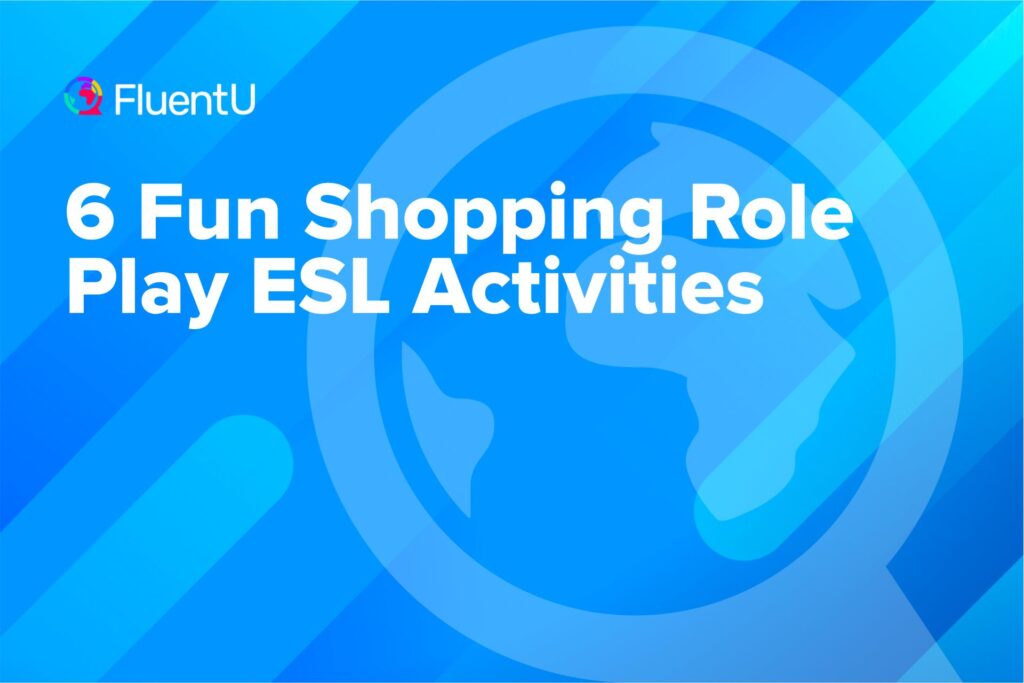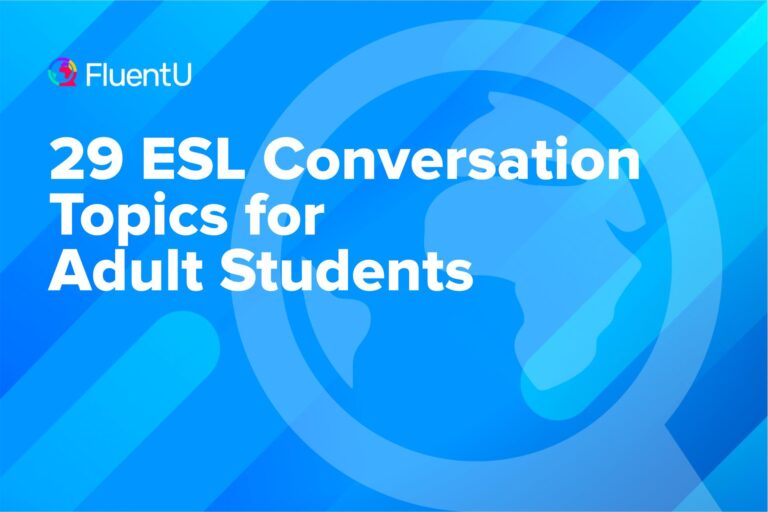6 Fun Shopping Role Play ESL Activities

When learning a new language, shopping is one of the first places you get to actually use the language.
I remember landing in Barcelona for the first time, and when I needed eye drops and communicated in Spanish to a pharmacy clerk, I was so proud of myself.
To teach shopping terminology and phrases, you could simply print out a worksheet of useful phrases and have them study it, but there’s something that works so much better: shopping role play ESL activities.
I’ve compiled six awesome shopping role play activities for you to use in your class to get your students communicating and talking while “shopping.”
They’re not only very useful, they’re also fun. I’ve also included lots of example questions that students would use while shopping, and some cultural considerations to shopping in English speaking countries.
Download: This blog post is available as a convenient and portable PDF that you can take anywhere. Click here to get a copy. (Download)
1. At the Clothing Shop
Role A: Shopper
Role B: Clerk
B: Hi! Welcome to the Clothes Shop! Can I help you find anything?
A: Yes, I’m looking for (clothes item). Where do you have them?
B: They are all over there. What (style/color) are you looking for?
A: I am looking for (your choice). Do you have anything like that?
B: No, I’m sorry but we’re all out of that. Is there anything else you may like?
A: Yes. Do you have (different clothes item) in (size)?
B: Yes, what color would you like?
A: Do you have (product) in (favorite color)?
B: Yes, how about this one/these?
A: Wonderful! How much is it/are they?
B: It’s/They’re $49.99
A: Can I pay with a MasterCard?
B: Yes, we accept all major credit cards.
A: Excellent, thank you!
2. In the Electronics Shop
Role A: Clerk
Role B: Shopper
A: Hi! Welcome to ElectroShop!
B: Excuse me, do you have any (electronic product)?
A: Yes, what kind of (electronic product) are you looking for?
B: Do you have any (brand name) (electronic products)?
A: Yes, we have many. They’re all here.
B: I like this one. Can this one (verb)?
A: Not this one, but this one can.
B: Does this work with the older models?
A: Yes, it works with all models.
B: I like this one. Can I use this in (home country)?
A: Yes, these work all over the world.
B: Excellent, thank you! Where do I pay?
A: You’re welcome. You can pay in the front.
3. At the Superstore or Department Store
Role A: Shopper
Role B: Clerk
A: Excuse me, where is the (product) department?
B: It is over there to the left.
A: Do you have any (general products)?
B: It depends. What kind of (general product) are you looking for?
A: I want a (size), (color), (general product). Where can I find them?
B: Ah yes, we have those. Let me show you.
A: Perfect, can I pay with (your home country’s currency)?
B: Sorry, but we only accept US Dollars.
A: Not a problem. Can I return this if there is a problem?
B: Yes, you can refund it before 15 days.
A: Okay, thank you very much.
B: No problem.
4. The Supermarket
Role A: Shopper
Role B: Clerk
A: Excuse me, where are the (plural food item)?
B: They are all in the front, near the entrance.
A: Do you have a smaller (package of food item)?
B: No, that’s the only size we have.
A: Which type of (food item) do you recommend?
B: This one is very good, but a little more expensive. I love it.
A: Okay, I’ll buy it! Thank you kindly.
B: You’re very welcome.
5. In the Pharmacy
Role A: Shopper
Role B: Pharmacist
A: Hi, do you all have medicine for (medical problem)?
B: Yes, we have these different kinds.
A: Which do you recommend?
B: This one works very quickly but is more expensive. This one works a little more slowly but is cheaper. Both are good, it depends how bad you feel and how fast you want to recover.
A: Okay, I will buy this one. Can I pay with Apple Pay?
B: Yes, of course.
A: Thank you very much
B: You’re welcome, I hope you feel better soon.
6. At the Souvenir Shop
Role A: Shopper
Role B: Clerk
A: Hello!
B: Welcome! How are you doing?
A: I’m good, thank you. Do you have this shirt in (size)?
B: Not at the moment, but we have this shirt in (size) but in white.
A: Hmmm. No, white gets dirty quickly. Do you have it in (size) in another color?
B: Let me check. Yes, we also have it in red and green.
A: Okay, I’ll take the red one. Also, do you have any towels?
B: Yes, they are all over there.
A: I like all of them. I want them all, but can you all deliver to (home country)?
B: I’m sorry, we cannot deliver any products.
A: That’s alright. Okay, I’ll buy the red shirt and five towels. Can I pay with a check?
B: Yes, of course. That’ll be $73.26.
A: Here you are, thank you!
B: Thank you, have a nice day!
Bonus: Extra Shopping Phrases
These extra phrases are very helpful since they are quite common in the western shopping world.
Clerk: Can I help you with anything?
Shopper: No thank you, I’m just looking.
Clerk: Can I help you with anything else?
Shopper: No, that’s alright, thank you!
Clerk: Would you like (something you don’t want—for example, gift-wrapping, a receipt, a bag or a complimentary candy)?
Shopper: No thank you, just this is fine.
Shopper: Excuse me, do you have a bathroom?
Clerk: I’m sorry, we don’t have a bathroom here.
Shopper: Where is the nearest bathroom?
Shopper: Excuse me, do you work here? (Said to somebody who looks like they work at the shop.)
Shopper: How much is the total after tax?
Shopper: Is there another (kind of shop) around here?
With all of these phrases and role plays, your students will learn everything they will ever need to learn about navigating stores while traveling, shopping or working in an English-speaking country (or doing the same in their home countries).
Most students really look forward to the shopping experiences foreign countries have to offer, so they get excited for any related activities! On top of that, you are offering them a real professional advantage with this knowledge.
Feel free to mix up the activities and change things up every once in a while. Rotate which ones you use in class. You can even use visual aids, things around the class or some props to make the role plays more in-depth.
For example, try bringing in items that could be bought or sold during the role plays, or bring costumes for the customers and clerks to wear.
Tips to Give ESL Students About Shopping in English
Haggling isn’t always culturally acceptable
If students are visiting an English-speaking country or (any other) that is in the western world like the U.S, Canada, the U.K. or Australia, let them know that while it may be okay to negotiate and haggle in their home country, haggling almost never happens in English-speaking countries (unless you’re at a flea market or garage sale).
The good news is that you do not have to cover things like negotiating and haggling in these activities!
Employees are often trained to be more forward and social
Again, if students are visiting one of the English-speaking countries in the western world, the clerks will usually approach them with a “Can I help you with anything?” or something along those lines.
Clerks and salespeople are often trained to seek out and interact with customers. They try to be friendly, social and helpful.
This is often perceived oddly by people from different cultures, so let your students know that it is normal for shop employees to make first contact with the customer.
Employees want to help
Shopping in the western world, your students might find themselves to be more closely catered to than in their home country.
Employees will (or at least should) be glad to help you, so let the students know that they are not bothering them or being intrusive by asking for assistance. That is what the shop employees are there for, and they are often paid better or looked upon more favorably by management for delivering great service!
Areas of Shopping English to Focus On
While shopping in English, there are different categories that you may have questions about. This probably does not differ from their shopping situation at home, but it helps to categorize things and make them easier to teach and learn.
For an easy way to model everyday English interactions such as shopping with fun native content, be sure to check out FluentU.
FluentU takes authentic videos—like music videos, movie trailers, news and inspiring talks—and turns them into personalized language learning lessons.
You can try FluentU for free for 2 weeks. Check out the website or download the iOS app or Android app.
P.S. Click here to take advantage of our current sale! (Expires at the end of this month.)

Your students will be absorbed in the enjoyable content while learning about English norms and speaking!
Location
Since Western shops can be very, very large and have an abundance of products, things are all over the place. Some common questions ask where things are, where some departments are or where the bathroom is.
Common location questions:
- Where is the (singular product)?
- Where are the (plural product)?
- Where is the (product) department?
- Where is the (bathroom/cash register/customer service desk)?
Specifications
There are so many things in so many colors, shapes, sizes, brands, models and more. It is overwhelming sometimes, but knowing what questions to ask about the specific aspects of the product you are looking for can really help out.
Common specifications questions:
- Do you have this/these in color/size/material?
- Do you have (brand name) (products)? — For example, “Do you have Nike athletic shoes?”
- What (color/size/material) do you have this/these in?
Price
This one is vital especially since some things do not have price tags on them (I’m looking at you Wal-Mart!). This will come in handy when your students are out there in the big shopping world and cannot find the price anywhere.
Common price questions:
- How much is this?
- How much are these/those?
Payment
Most English-speaking countries love money. They do not want to refuse money in any shape or form, so they are starting to accept all sorts of payment methods.
So, what should your student do when they are unsure about a store’s accepted payment methods?
The best way to approach the situation is typically to decide how they want to pay (whether it is a foreign credit card, Apple or Google Pay or cash) and ask the simple question “Can I pay with (payment method)?
It works much easier than asking how you could pay than getting a list of all acceptable payment methods, but one may certainly ask, “What are your accepted forms of payment?”
They should be prepared to hear and give answers of “cash only,” “credit,” “debit” and “checks.” They might also want to learn how to talk about a “credit minimum.”
Function and use
This one is important too since some products may work for all desired purposes, while other products are meant for more specific purposes or perhaps have some limitations. If the students want to make sure something works with something else or in some specific way while shopping, then it is good to ask about functionality before they drop the money on it.
Common functionality questions:
- Does this work with (other product)?
- Can this (verb)?
- Can I use this to (verb)?
Refunds and exchanges
The western world loves to please the customer to make shopping an”experience,” and one way they do this is with exchanges and returns.
It is not uncommon that some shops in certain countries will give exchanges and/or returns after purchase, so it is a good idea to learn some phrases that could be useful in case something happens (while the student is still in the visited country, of course)
Common refunds and exchanges questions:
- Can I exchange this if (situation)?
- What is the return/exchange policy?
Other shopping questions
Since shopping in English-speaking countries is known for being more of an “experience” than just making purchases, there are a few different things to consider that you may have questions for along the way.
These questions may cover delivery options, availability or even some recommendations for usage. Always let students know that it is very normal for customers to ask the clerks what they would recommend, no matter what kind of shop it is.
Other common shopping questions:
- Can you deliver this to (place)?
- When will (product) be available?
- What (product/color/style) do you recommend?
Now that the students know a simple rundown and useful phrases for their shopping experience in an English-speaking country, on to the role play activities! You will see some phrases frequently used as well as some tricky yet common situations.
Role play activities like these will help make the shopping experience an engaging and exciting one! That is, until they see their next credit card statement.
Now, to the shops!
Download: This blog post is available as a convenient and portable PDF that you can take anywhere. Click here to get a copy. (Download)







